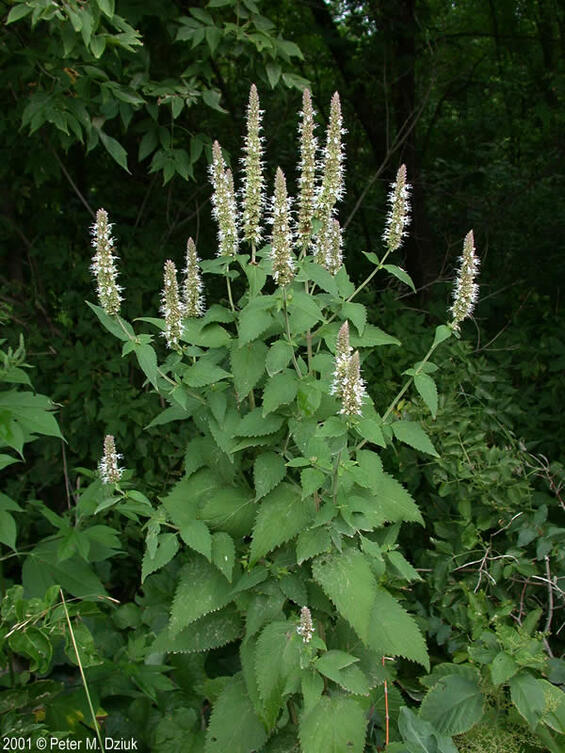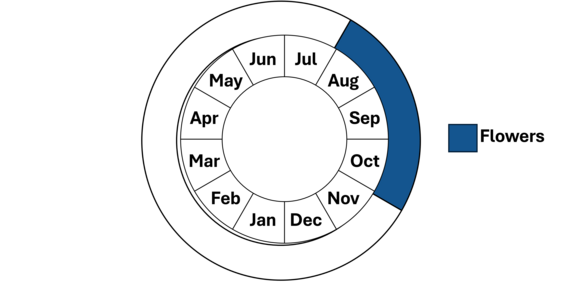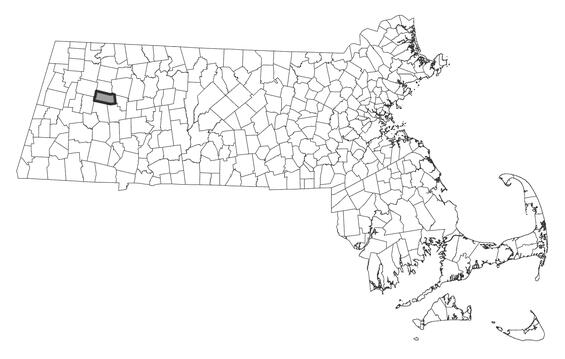- Scientific name: Agastache scrophulariifolia (Willd.) Kuntze
- Species of Greatest Conservation Need (MA State Wildlife Action Plan)
- Endangered (MA Endangered Species Act)
Description

Purple giant hyssop. Image credit: Peter M. Dziuk, MinnesotaWildflowers.info
Purple giant hyssop is an aromatic perennial species in the mint family (Lamiaceae) found in rich, moist woods and along riverbanks. It is currently known from only one location in Massachusetts. Purple giant hyssop has four-sided stems that are diamond-shaped in cross-section, with opposite, toothed leaves. The flower stems reach 1-1.5 m in height (~ 3-5 feet), branch near the top, and have terminal spike-like inflorescences up to 15 cm (5.9 in) in length, with tubular purplish flowers.
A technical key should be used to distinguish purple giant hyssop from other mint species. Distinguishing characteristics include: tall stature (1-1.5 m; 39-60 in), anise-like fragrance of crushed leaves, stem diamond-shaped in cross-section, and long, spike-like inflorescence with crowded, purple flowers. Purple giant hyssop is the only native Agastache species in Massachusetts. It is distinguished from a non-native hybrid that occasionally escapes from plantings (Agastache foeniculum x A. rugosa) by the green underside of its leaves, a smooth calyx, and middle leaves with long petioles.

Population status
Purple giant hyssop is listed under the Massachusetts Endangered Species Act as Endangered. All listed species are protected from killing, collecting, possessing, or sale, and from activities that would destroy habitat and thus directly or indirectly cause mortality or disrupt critical behaviors. Purple giant hyssop is currently known from Hampshire County, and it occurred historically in Berkshire and Suffolk counties. The MassWildlife’s Natural Heritage & Endangered Species Program (NHESP) database has 3 records from 3 counties: Suffolk, Berkshire, and Hampshire. Only 1 of these records has been observed within the last 25 years; and only a few plants were observed in that location.
Distribution and abundance
Purple giant hyssop is found from New Hampshire and Ontario west to South Dakota to Kansas; it occurs throughout much of the Midwest and the Mid-Atlantic region south to Georgia. It is critically imperiled in several states and may have been extirpated from Georgia. In New England, it is critically imperiled in Connecticut and Massachusetts, possibly extirpated from Vermont and is not known from Maine or Rhode Island.

Distribution in Massachusetts
1999-2024
Based on records in the Natural Heritage Database
Habitat
Purple giant hyssop is currently known from only one location in Massachusetts, in rich mesic woods in Hampshire County. Associated species include sugar maple (Acer saccharum), basswood (Tilia americana), white ash (Fraxinus americana), goldie’s wood-fern (Dryopteris goldiana), zigzag goldenrod (Solidago flexicaulis), and white baneberry (Actaea pachypoda). Habitat requirements have not been well-described, but the species is thought to require moderate sunlight and some disturbance to expose mineral soil for successful seed establishment. Purple giant hyssop may also occur in rich soil, along riverbanks, and in roadside thickets.
Healthy habitats are vital for supporting native wildlife and plants. Explore habitats and learn about conservation and restoration in Massachusetts.
Threats
Purple giant hyssop may be threatened by deer browse, dense shade, or lack of disturbances that create a mineral-soil seed bed. It may also be very sensitive early in the spring to trampling before it emerges from ramps collectors.
Conservation
Management
Fencing to prevent deer browse with management to increase light and scarify soils may be useful. Caution is needed to prevent invasive species establishment, which may threaten purple giant hyssop. All active management of rare plant populations (including invasive species removal) is subject to review under the Massachusetts Endangered Species Act and should be planned in close consultation with NHESP.
References
Corrigan, E. E. 2002. Agastache scrophulariifolia (Willd.) Kuntze (purple giant hyssop) Conservation and Research Plan for New England. New England Wild Flower Society, Framingham, MA.
Haines, A. 2011. Flora Novae Angliae – A Manual for the Identification of Native and Naturalized Higher Vascular Plants of New England. New England Wild Flower Society. Yale University Press, New Haven, CT.
NatureServe. 2025. NatureServe Network Biodiversity Location Data accessed through NatureServe Explorer [web application]. NatureServe, Arlington, Virginia. Available https://explorer.natureserve.org/. Accessed: 6/5/2025.
Rhoads, A. F., and T. A. Block. 2000. The Plants of Pennsylvania: an Illustrated Manual. Univ. of Pennsylvania Press, Philadelphia, PA.
Contact
| Date published: | June 10, 2025 |
|---|